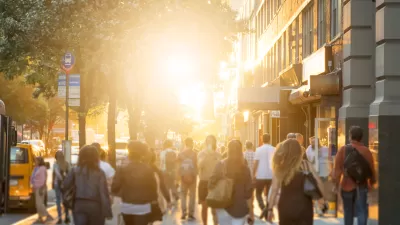Last Friday, I was in two different suburban environments in Atlanta. Both are sprawl by any normal definition of the term - car-oriented environments where residential streets are separated from commerce, sidewalks are rare, and densities are low. But the two places are as different as sprawl and new urbanism.
Last Friday, I was in two different suburban environments in
Atlanta. Both are sprawl by any normal definition of
the term - car-oriented environments where residential streets are separated from commerce, sidewalks are rare, and densities are low. But the two places are as different
as sprawl and new urbanism.
On the way into town, I prayed at a synagogue in Sandy Springs (an inner ring suburb) and then walked
along a residential street to a nearby commercial street Both the residential street and commercial
street were not very pedestrian-friendly: there were no sidewalks on the residential
street, and the commercial street was perhaps a couple of lanes too wide to be
truly comfortable for pedestrians.
But this area (or as I call it, "Sprawl Heck") has its
consolations. While the residential
street did lack sidewalks, it at least had lawns to walk on so I didn't have to
walk in the street most of the time (much like these streets from
neighboring Atlanta suburbs:
http://atlantaphotos.fotopic.net/p14010326.html
and
http://atlantaphotos.fotopic.net/p14010324.html )
Traffic calming measures kept Sprawl Heck cars
going relatively safe speeds. And even
though the residential streets don't connect very well to each other, they are
reasonably close to a commercial street with sidewalks and bus stops.
By contrast, I spent the rest of the weekend with family
members. They live in an area that I
would describe as "Sprawl Hell." In
Sprawl Hell, trees go right up to the street so there's no way to avoid walking
on the street. And on many of Sprawl
Hell's residential streets, traffic goes 40 mph. So in Sprawl Hell, walking can be pretty
dangerous.
(For some examples, see
http://atlantaphotos.fotopic.net/p50930564.html
and
http://atlantaphotos.fotopic.net/p50930560.html )
And the nearest commercial street, about a mile and a half
away, is a highway which also lacks sidewalks:
http://atlantaphotos.fotopic.net/p50930562.html
In sum, not all car-oriented suburbs are equally bad. The mere addition of sidewalks, or some limits on
foliage near streets, can elevate a suburb from terrible to merely mediocre.

Manufactured Crisis: Losing the Nation’s Largest Source of Unsubsidized Affordable Housing
Manufactured housing communities have long been an affordable housing option for millions of people living in the U.S., but that affordability is disappearing rapidly. How did we get here?

Americans May Be Stuck — But Why?
Americans are moving a lot less than they once did, and that is a problem. While Yoni Applebaum, in his highly-publicized article Stuck, gets the reasons badly wrong, it's still important to ask: why are we moving so much less than before?

Using Old Oil and Gas Wells for Green Energy Storage
Penn State researchers have found that repurposing abandoned oil and gas wells for geothermal-assisted compressed-air energy storage can boost efficiency, reduce environmental risks, and support clean energy and job transitions.

Updating LA’s Tree Rules Could Bring More Shade to Underserved Neighborhoods
A new USC study finds that relaxing Los Angeles’ outdated tree planting guidelines could significantly expand urban tree canopy and reduce shade disparities in lower-income neighborhoods, though infrastructure investments are also needed.

California's Canal Solar Projects Aim to Conserve Resources and Expand Clean Energy
California’s Project Nexus has begun generating electricity from solar panels installed over irrigation canals, with researchers and state agencies exploring statewide expansion to conserve water and boost clean energy production.

HHS Staff Cuts Gut Energy Assistance Program
The full staff of a federal program that distributes heating and cooling assistance for low-income families was laid off, jeopardizing the program’s operations.
Urban Design for Planners 1: Software Tools
This six-course series explores essential urban design concepts using open source software and equips planners with the tools they need to participate fully in the urban design process.
Planning for Universal Design
Learn the tools for implementing Universal Design in planning regulations.
Heyer Gruel & Associates PA
City of Moreno Valley
Institute for Housing and Urban Development Studies (IHS)
City of Grandview
Harvard GSD Executive Education
Salt Lake City
NYU Wagner Graduate School of Public Service
City of Cambridge, Maryland




























